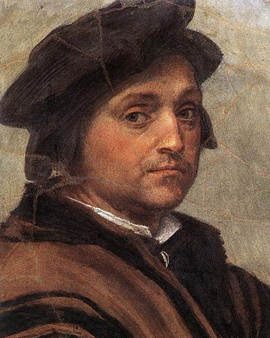Andrea del Sartos real name was Andrea d'Angelo di Francesco. His nickname derives from his father's profession, who was a tailor. Del Sarto was of remarkably small height, which is why his friends liked to call him Andreino. Originally, Del Sarto began training with a goldsmith, but his drawing skills caught the attention of a local painter, who first taught him himself and later referred him to Piero di Cosimo. In his work, however, del Sarto oriented himself less to his master and more to Raphael, Leonardo da Vinci and Fra Bartolommeo, whose different styles he knew how to combine in an inimitable way. During his lifetime he achieved high esteem and even received the nickname Andrea sensa errori, which means flawless Andrea. After his death, however, he was marginalized, mainly because other great masters of his time, such as da Vinci, Raphael and Michelangelo, surpassed him artistically.
Del Sarto married Lucrezia del Fede at the age of about 31, who sat as a model for him several times and often served as the model for his Madonna paintings. Lucrezia was the wealthy widow of a hatter. The marriage therefore brought del Sarto some financial comforts. It is therefore not surprising that del Sarto showed only moderate enthusiasm for work. He painted when it suited him and also the payment was rather secondary for him. His student and later biographer Vasari, who was introduced to him by Michelangelo, complained about this fact. Vasari acknowledged that del Sarto had a high degree of talent, but his teacher lacked the fiery ambition and divine inspiration that would make a great artist. His opinion of del Sarto's wife was even lower. He described her as jealous, disloyal and quarrelsome.
Apart from two short periods, del Sarto spent his entire life in Florence. Around 1518 the French court became aware of del Sarto's talent and King Francois I invited the painter to Fontainbleau. Del Sarto accepted the invitation and went to Paris without his wife, but with one of his students Andrea Squarzzella. However, the stay was only of short duration. Some assume that Del Sarto did not see himself as a court artist and felt mentally underchallenged. For in his short time at court, he did not produce a single work. According to Vasari, however, Lucrezia is said to have ordered her husband back to Florence. Del Sarto was allowed to return with the king's permission, but should return to court as soon as possible. The king also gave del Sarto money to buy some paintings in Italy for his art collection. But del Sarto never returned and instead bought a house in Florence with the king's money. Between 1520 and his death in 1530, he worked only there until he was finally infected with the bubonic plague and died.
×





.jpg)
.jpg)
.jpg)
.jpg)
.jpg)
.jpg)
.jpg)
.jpg)
.jpg)
.jpg)
_-_(MeisterDrucke-900293).jpg)
_-_(MeisterDrucke-900293).jpg)
.jpg)
.jpg)
.jpg)
.jpg)
.jpg)
.jpg)
 - (MeisterDrucke-150021).jpg)
 - (MeisterDrucke-150021).jpg)
_-_(MeisterDrucke-1630468).jpg)
_-_(MeisterDrucke-1630468).jpg)
.jpg)
.jpg)
.jpg)
.jpg)
 - (MeisterDrucke-43900).jpg)
 - (MeisterDrucke-43900).jpg)
_-_(MeisterDrucke-1001638).jpg)
_-_(MeisterDrucke-1001638).jpg)
_(altarpiece)_-_(MeisterDrucke-259407).jpg)
_(altarpiece)_-_(MeisterDrucke-259407).jpg)
.jpg)
.jpg)
.jpg)
.jpg)
.jpg)
.jpg)
.jpg)
.jpg)
_Peinture_d_Andrea_del_Sarto_(1486-1531)_-_(MeisterDrucke-1031373).jpg)
_Peinture_d_Andrea_del_Sarto_(1486-1531)_-_(MeisterDrucke-1031373).jpg)
 - (MeisterDrucke-91563).jpg)
 - (MeisterDrucke-91563).jpg)
_-_(MeisterDrucke-996242).jpg)
_-_(MeisterDrucke-996242).jpg)
.jpg)
.jpg)
_-_(MeisterDrucke-389259).jpg)
_-_(MeisterDrucke-389259).jpg)
 - (MeisterDrucke-166400).jpg)
 - (MeisterDrucke-166400).jpg)
.jpg)
.jpg)
.jpg)
.jpg)
.jpg)
.jpg)
_-_(MeisterDrucke-1637251).jpg)
_-_(MeisterDrucke-1637251).jpg)
.jpg)
.jpg)
.jpg)
.jpg)
.jpg)
.jpg)
.jpg)
.jpg)
_or_portrait_of_youn_-_(MeisterDrucke-1023461).jpg)
_or_portrait_of_youn_-_(MeisterDrucke-1023461).jpg)
_-_(MeisterDrucke-575611).jpg)
_-_(MeisterDrucke-575611).jpg)
.jpg)
.jpg)
.jpg)
.jpg)
.jpg)
.jpg)
.jpg)
.jpg)
.jpg)
.jpg)
_by_Andrea_DAgnolo_known_as_Andrea_del_Sarto_-_(MeisterDrucke-1513421).jpg)
_by_Andrea_DAgnolo_known_as_Andrea_del_Sarto_-_(MeisterDrucke-1513421).jpg)
.jpg)
.jpg)
 - (MeisterDrucke-174641).jpg)
 - (MeisterDrucke-174641).jpg)
.jpg)
.jpg)
.jpg)
.jpg)
_(1486-1530)_-_(MeisterDrucke-961384).jpg)
_(1486-1530)_-_(MeisterDrucke-961384).jpg)
_-_(MeisterDrucke-1094181).jpg)
_-_(MeisterDrucke-1094181).jpg)
.jpg)
.jpg)
_-_(MeisterDrucke-406773).jpg)
_-_(MeisterDrucke-406773).jpg)
.jpg)
.jpg)
.jpg)
.jpg)
.jpg)
.jpg)
.jpg)
.jpg)
.jpg)
.jpg)
.jpg)
.jpg)
.jpg)
.jpg)
 - (MeisterDrucke-111706).jpg)
 - (MeisterDrucke-111706).jpg)
.jpg)
.jpg)
.jpg)
.jpg)
.jpg)
.jpg)
_of_the_Holy_Family_Palatina_Gallery_Pitti_-_(MeisterDrucke-636512).jpg)
_of_the_Holy_Family_Palatina_Gallery_Pitti_-_(MeisterDrucke-636512).jpg)
.jpg)
.jpg)
.jpg)
.jpg)
.jpg)
.jpg)
_16th_century_Sun_-_(MeisterDrucke-947177).jpg)
_16th_century_Sun_-_(MeisterDrucke-947177).jpg)
.jpg)
.jpg)
.jpg)
.jpg)
.jpg)
.jpg)
.jpg)
.jpg)
.jpg)
.jpg)
 - (MeisterDrucke-161759).jpg)
 - (MeisterDrucke-161759).jpg)
.jpg)
.jpg)
.jpg)
.jpg)
.jpg)
.jpg)
.jpg)
.jpg)
.jpg)
.jpg)
_-_(MeisterDrucke-1112821).jpg)
_-_(MeisterDrucke-1112821).jpg)
_1522_Dim_379x222_c_-_(MeisterDrucke-1023458).jpg)
_1522_Dim_379x222_c_-_(MeisterDrucke-1023458).jpg)
.jpg)
.jpg)
.jpg)
.jpg)
.jpg)
.jpg)
.jpg)
.jpg)
.jpg)
.jpg)
_-_(MeisterDrucke-984217).jpg)
_-_(MeisterDrucke-984217).jpg)
.jpg)
.jpg)
.jpg)
.jpg)
.jpg)
.jpg)
.jpg)
.jpg)
.jpg)
.jpg)
.jpg)
.jpg)
_-_(MeisterDrucke-972334).jpg)
_-_(MeisterDrucke-972334).jpg)
 - (MeisterDrucke-166710).jpg)
 - (MeisterDrucke-166710).jpg)
.jpg)
.jpg)
.jpg)
.jpg)
.jpg)
.jpg)
_by_Andrea_DAgnolo_known_as_Andrea_del_Sarto_-_(MeisterDrucke-1512650).jpg)
_by_Andrea_DAgnolo_known_as_Andrea_del_Sarto_-_(MeisterDrucke-1512650).jpg)
_Two_Studies_of_Legs_(verso)_-_(MeisterDrucke-1595606).jpg)
_Two_Studies_of_Legs_(verso)_-_(MeisterDrucke-1595606).jpg)
.jpg)
.jpg)
.jpg)
.jpg)






